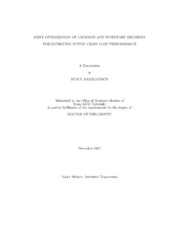| dc.description.abstract | This dissertation is focused on investigating the integration of inventory and facility
location decisions in different supply chain settings. Facility location and inventory
decisions are interdependent due to the economies of scale that are inherent in transportation
and replenishment costs. The facility location decisions have an impact
on the transportation and replenishment costs which, in turn, affect the optimal inventory
policy. On the other hand, the inventory policy dictates the frequency of
shipments to replenish inventory which, in turn, affects the number of deliveries, and,
hence, the transportation costs, between the facilities. Therefore, our main research
objectives are to:
• compare the optimal facility location, determined by minimizing total transportation
costs, to the one determined by the models that also consider the
timing and quantity of inventory replenishments and corresponding costs,
• investigate the effect of facility location decisions on optimal inventory decisions,
and
• measure the impact of integrated decision-making on overall supply chain cost performance.
Placing a special emphasis on the explicit modeling of transportation costs, we
develop several novel models in mixed integer linear and nonlinear optimization programming.
Based on how the underlying facility location problem is modeled, these
models fall into two main groups: 1) continuous facility location problems, and 2)
discrete facility location problems. For the stylistic models, the focus is on the development
of analytical solutions. For the more general models, the focus is on the
development of efficient algorithms. Our results demonstrate
• the impact of explicit transportation costs on integrated decisions,
• the impact of different transportation cost functions on integrated decisions in
the context of continuous facility location problems of interest,
• the value of integrated decision-making in different supply chain settings, and
• the performance of solution methods that jointly optimize facility location and
inventory decisions. | en |


